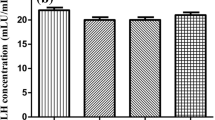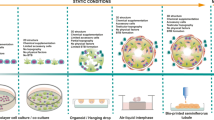Abstract
Human exposure to environmental contaminants is widespread. Some of these contaminants have the ability to interfere with adipogenesis, being thus considered as obesogens. Recently, obesogens have been singled out as a cause of male infertility. Sertoli cells (SCs) are essential for male fertility and their metabolic performance, especially glucose metabolism, is under a tight endocrine control, being essential for the success of spermatogenesis. Herein, we studied the impact of the model obesogen tributyltin in the metabolic profile of SCs. For that, ex vivo-cultured rat SCs were exposed to increasing doses of tributyltin. SCs proliferation was evaluated by the sulforhodamine B assay and the maturation state of the cells was assessed by the expression of specific markers (inhibin B and the androgen receptor) by quantitative polymerase chain reaction. The metabolic profile of SCs was established by studying metabolites consumption/production by nuclear magnetic resonance spectroscopy and by analyzing the expression of key transporters and enzymes involved in glycolysis by Western blot. The proliferation of SCs was only affected in the cells exposed to the highest dose (1000 nM) of tributyltin. Notably, SCs exposed to 10 nM tributyltin decreased the consumption of glucose and pyruvate, as well as the production of lactate. The decreased lactate production hampers the development of germ cells. Intriguingly, the lowest levels of tributyltin were more prone to modulate the expression of key players of the glycolytic pathway. This is the first study showing that tributyltin reprograms glucose metabolism of SCs under ex vivo conditions, suggesting new targets and mechanisms through which obesogens modulate the metabolism of SCs and thus male (in)fertility.




Similar content being viewed by others
Abbreviations
- 1H-NMR:
-
Proton nuclear magnetic resonance
- AR:
-
Androgen receptor
- β2MG:
-
β2-Microglobulin
- CAMs:
-
Cell adhesion molecules
- cDNA:
-
Complementary deoxyribonucleic acid
- DMEM:F12:
-
Dulbecco’s modified eagle medium Ham’s nutrient mixture F12
- EtOH:
-
Ethanol
- GLUT1:
-
Glucose transporter 1
- GLUT2:
-
Glucose transporter 2
- GLUT3:
-
Glucose transporter 3
- GLUTs:
-
Glucose transporters
- HBSS:
-
Hank’s balanced salts solution
- ITS:
-
Insulin–transferrin–sodium selenite
- LDH:
-
Lactate dehydrogenase
- MCT4:
-
Monocarboxylate transporter 4
- PBS:
-
Phosphate-buffered Saline
- PFK1:
-
Phosphofructokinase 1
- PPARy:
-
Peroxisome proliferator-activated receptor gamma
- RXR:
-
Retinoid X receptor
- SCs:
-
Sertoli cells
- SRB:
-
Colorimetric sulforhodamine B
- T:
-
Testosterone
- TBT:
-
Tributyltin
References
Adhikari N, Sinha N, Saxena D (2000) Effect of lead on Sertoli–germ cell coculture of rat. Toxicol Lett 116(1):45–49
Alves MG, Neuhaus-Oliveira A, Moreira PI, Socorro S, Oliveira PF (2013a) Exposure to 2,4-dichlorophenoxyacetic acid alters glucose metabolism in immature rat Sertoli cells. Reprod Toxicol 38:81–88. doi:10.1016/j.reprotox.2013.03.005
Alves MG, Rato L, Carvalho RA, Moreira PI, Socorro S, Oliveira PF (2013b) Hormonal control of Sertoli cell metabolism regulates spermatogenesis. Cell Mol Life Sci 70(5):777–793
Antizar-Ladislao B (2008) Environmental levels, toxicity and human exposure to tributyltin (TBT)-contaminated marine environment. A review. Environ Int 34(2):292–308. doi:10.1016/j.envint.2007.09.005
Bajpai M, Gupta G, Setty B (1998) Changes in carbohydrate metabolism of testicular germ cells during meiosis in the rat. Eur J Endocrinol 138(3):322–327
Bizarro P, Acevedo S, Nino-Cabrera G et al (2003) Ultrastructural modifications in the mitochondrion of mouse Sertoli cells after inhalation of lead, cadmium or lead–cadmium mixture. Reprod Toxicol 17(5):561–566
Cardoso AM, Alves MG, Mathur PP, Oliveira PF, Cavaco JE, Rato L (2017) Obesogens and male fertility. Obes Rev 18(1):109–125. doi:10.1111/obr.12469
D’Cruz SC, Jubendradass R, Jayakanthan M, Rani SJ, Mathur PP (2012) Bisphenol A impairs insulin signaling and glucose homeostasis and decreases steroidogenesis in rat testis: an in vivo and in silico study. Food Chem Toxicol 50(3–4):1124–1133. doi:10.1016/j.fct.2011.11.041
Ferreira M, Blanco L, Garrido A, Vieites JM, Cabado AG (2013) In vitro approaches to evaluate toxicity induced by organotin compounds tributyltin (TBT), dibutyltin (DBT), and monobutyltin (MBT) in neuroblastoma cells. J Agric Food Chem 61(17):4195–4203
Grootegoed JA, Oonk RB, Jansen R, van der Molen HJ (1986) Metabolism of radiolabelled energy-yielding substrates by rat Sertoli cells. J Reprod Fertil 77(1):109–118
Grun F, Blumberg B (2009a) Endocrine disrupters as obesogens. Mol Cell Endocrinol 304(1–2):19–29. doi:10.1016/j.mce.2009.02.018
Grun F, Blumberg B (2009b) Minireview: the case for obesogens. Mol Endocrinol 23(8):1127–1134. doi:10.1210/me.2008-0485
Grün F, Blumberg B (2006) Environmental obesogens: organotins and endocrine disruption via nuclear receptor signaling. Endocrinology 147(6):s50–s55. doi:10.1210/en.2005-1129
Grun F, Watanabe H, Zamanian Z et al (2006) Endocrine-disrupting organotin compounds are potent inducers of adipogenesis in vertebrates. Mol Endocrinol 20(9):2141–2155
Hutchison GR, Scott HM, Walker M et al (2008) Sertoli cell development and function in an animal model of testicular dysgenesis syndrome. Biol Reprod 78(2):352–360
Janesick A, Blumberg B (2012) Obesogens, stem cells and the developmental programming of obesity. Int J Androl 35(3):437–448. doi:10.1111/j.1365-2605.2012.01247.x
Jesus TT, Oliveira PF, Silva J et al (2016) Mammalian target of rapamycin controls glucose consumption and redox balance in human Sertoli cells. Fertil Steril 105(3):825–833. doi:10.1016/j.fertnstert.2015.11.032
Johnson JH, Newgard CB, Milburn JL, Lodish HF, Thorens B (1990) The high Km glucose transporter of islets of Langerhans is functionally similar to the low affinity transporter of liver and has an identical primary sequence. J Biol Chem 265(12):6548–6551
Kannan K, Takahashi S, Fujiwara N, Mizukawa H, Tanabe S (2010) Organotin compounds, including butyltins and octyltins, in house dust from Albany, New York, USA. Arch Environ Contam Toxicol 58(4):901–907. doi:10.1007/s00244-010-9513-6
Kim S-K, Kim J-H, Han JH, Yoon Y-D (2008) Inhibitory effect of tributyltin on expression of steroidogenic enzymes in mouse testis. Int J Toxicol 27(2):175–182
Lahlou N, Bouvattier C, Linglart A, Rodrigue D, Teinturier C (2008) The role of gonadal peptides in clinical investigation. Ann Biol Clin (Paris) 67(3):283–292
Levine KE, Young DJ, Afton SE et al (2015) Development, validation, and application of an ultra-performance liquid chromatography-sector field inductively coupled plasma mass spectrometry method for simultaneous determination of six organotin compounds in human serum. Talanta 140:115–121. doi:10.1016/j.talanta.2015.03.022
Mello MSC, Delgado IF, Favareto APA et al (2015) Sexual maturation and fertility of mice exposed to triphenyltin during prepubertal and pubertal periods. Toxicol Rep 2:405–414
Mitra S, Srivastava A, Khandelwal S (2013) Tributyltin chloride induced testicular toxicity by JNK and p38 activation, redox imbalance and cell death in sertoli-germ cell co-culture. Toxicology 314(1):39–50. doi:10.1016/j.tox.2013.09.003
Mitra S, Srivastava A, Khanna S, Khandelwal S (2014) Consequences of tributyltin chloride induced stress in Leydig cells: an ex vivo approach. Environ Toxicol Pharmacol 37(2):850–860
Monsees T, Franz M, Gebhardt S, Winterstein U, Schill W, Hayatpour J (2000) Sertoli cells as a target for reproductive hazards. Andrologia 32(4–5):239
Oliveira PF, Cheng CY, Alves MG (2017) Emerging role for mammalian target of rapamycin in male fertility. Trends Endocrinol Metab 28(3):165–167. doi:10.1016/j.tem.2016.12.004
Pfaffl MW (2001) A new mathematical model for relative quantification in real-time RT–PCR. Nucleic Acids Res 29(9):e45
Rato L, Alves M, Socorro S, Carvalho RA, Cavaco JE, Oliveira PF (2012) Metabolic modulation induced by estradiol and DHT in immature rat Sertoli cells cultured in vitro. Biosci Rep 32(1):61–69. doi:10.1042/BSR20110030
Rato L, Alves M, Dias T et al (2013) High-energy diets may induce a pre-diabetic state altering testicular glycolytic metabolic profile and male reproductive parameters. Andrology 1(3):495–504
Rato L, Alves M, Dias T, Cavaco J, Oliveira PF (2015a) Testicular metabolic reprogramming in neonatal streptozotocin-induced type 2 diabetic rats impairs glycolytic flux and promotes glycogen synthesis. J Diabetes Res. doi:10.1155/2015/973142
Rato L, Alves MG, Duarte AI et al (2015b) Testosterone deficiency induced by progressive stages of diabetes mellitus impairs glucose metabolism and favors glycogenesis in mature rat Sertoli cells. Int J Biochem Cell Biol 66:1–10
Rato L, Meneses MJ, Silva BM, Sousa M, Alves MG, Oliveira PF (2016) New insights on hormones and factors that modulate Sertoli cell metabolism. Histol Histopathol 31(5):499–513. doi:10.14670/HH-11-717
Raychoudhury SS, Flowers AF, Millette CF, Finlay MF (2000) Toxic effects of polychlorinated biphenyls on cultured rat Sertoli cells. J Androl 21(6):964–973
Reis M, Moreira AC, Sousa M, Mathur PP, Oliveira PF, Alves MG (2015) Sertoli cell as a model in male reproductive toxicology: advantages and disadvantages. J Appl Toxicol 35(8):870–883
Riera MF, Galardo MN, Pellizzari EH, Meroni SB, Cigorraga SB (2009) Molecular mechanisms involved in Sertoli cell adaptation to glucose deprivation. Am J Physiol Endocrinol Metab 297(4):E907–E914. doi:10.1152/ajpendo.00235.2009
Robeva R, Tomova A, Kirilov G, Kumanov P (2012) Anti-Mullerian hormone and inhibin B levels reflect altered Sertoli cell function in men with metabolic syndrome. Andrologia 44(Suppl 1):329–334. doi:10.1111/j.1439-0272.2011.01185.x
Robinson R, Fritz IB (1981) Metabolism of glucose by Sertoli cells in culture. Biol Reprod 24(5):1032–1041
Shoucri B, Blumberg B (2016) Impact of environmental obesogens. In: Goran MI (ed) Childhood obesity. CRC Press, Boca Raton, pp 219–234
Simpson IA, Dwyer D, Malide D, Moley KH, Travis A, Vannucci SJ (2008) The facilitative glucose transporter GLUT3: 20 years of distinction. Am J Physiol Endocrinol Metab 295(2):E242–E253
Singhal RL, Valadares J (1968) Metabolic control mechanisms in mammalian systems. Hormonal regulation of phosphofructokinase in the rat prostate and seminal vesicles. Biochem J 110(4):703–711
Sousa ACA, Pastorinho MR, Takahashi S, Tanabe S (2014) History on organotin compounds, from snails to humans. Environ Chem Lett 12(1):117–137. doi:10.1007/s10311-013-0449-8
Sousa AC, Coelho SD, Pastorinho MR et al (2017) Levels of TBT and other selected organotin compounds in duplicate diet samples. Sci Total Environ 574:19–23. doi:10.1016/j.scitotenv.2016.09.037
Tontonoz P, Spiegelman BM (2008) Fat and beyond: the diverse biology of PPARγ. Annu Rev Biochem 77:289–312
Uldry M, Ibberson M, Hosokawa M, Thorens B (2002) GLUT2 is a high affinity glucosamine transporter. FEBS Lett 524(1):199–203
Yamabe Y, Hoshino A, Imura N, Suzuki T, Himeno S (2000) Enhancement of androgen-dependent transcription and cell proliferation by tributyltin and triphenyltin in human prostate cancer cells. Toxicol Appl Pharmacol 169(2):177–184. doi:10.1006/taap.2000.9067
Yamada S, Kotake Y, Sekino Y, Kanda Y (2013) AMP-activated protein kinase-mediated glucose transport as a novel target of tributyltin in human embryonic carcinoma cells. Metallomics 5(5):484–491
Yamada S, Kotake Y, Demizu Y, Kurihara M, Sekino Y, Kanda Y (2014) NAD-dependent isocitrate dehydrogenase as a novel target of tributyltin in human embryonic carcinoma cells. Sci Rep 4:5952. doi:10.1038/srep05952
Acknowledgements
This work is supported by FEDER funds through the POCI—COMPETE 2020—Operational Programme Competitiveness and Internationalisation in Axis I—Strengthening research, technological development and innovation (Project No. 007491) and National Funds by FCT—Foundation for Science and Technology (Project UID/Multi/00709); CICECO (Ref. FCT UID/CTM/50011/2013); UMIB (PEst-OE/SAU/UI0215/2014). NMR data was collected at the UC-NMR facility which is supported in part by FEDER—European Regional Development Fund through the COMPETE Programme (Operational Programme for Competitiveness) and by National Funds through FCT—Fundação para a Ciência e a Tecnologia (Portuguese Foundation for Science and Technology) through Grants REEQ/481/QUI/2006, RECI/QEQ-QFI/0168/2012, CENTRO-07-CT62-FEDER-002012, and Rede Nacional de Ressonância Magnética Nuclear (RNRMN). P.F. Oliveira (PTDC/BBB-BQB/1368/2014 and IFCT2015); M.G. Alves (IFCT2015 and PTDC/BIM-MET/4712/2014)) and L. Rato was funded by Santander-Totta/University of Beira Interior (BIPD/ICI-CICS-BST-UBI).
Author information
Authors and Affiliations
Corresponding author
Ethics declarations
Conflict of interest
The authors declare no conflicts of interests.
Rights and permissions
About this article
Cite this article
Cardoso, A.M., Alves, M.G., Sousa, A.C. et al. The effects of the obesogen tributyltin on the metabolism of Sertoli cells cultured ex vivo. Arch Toxicol 92, 601–610 (2018). https://doi.org/10.1007/s00204-017-2091-x
Received:
Accepted:
Published:
Issue Date:
DOI: https://doi.org/10.1007/s00204-017-2091-x




